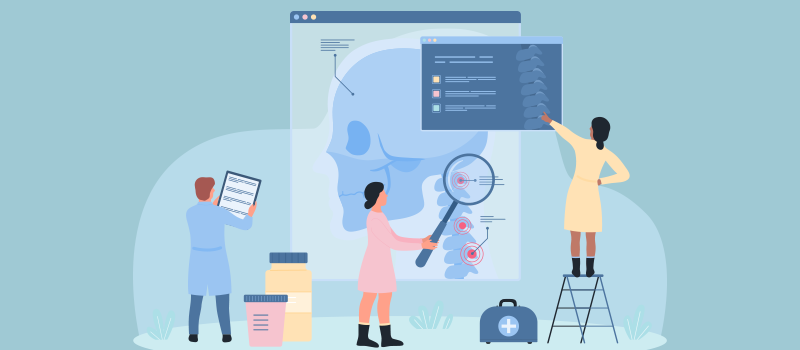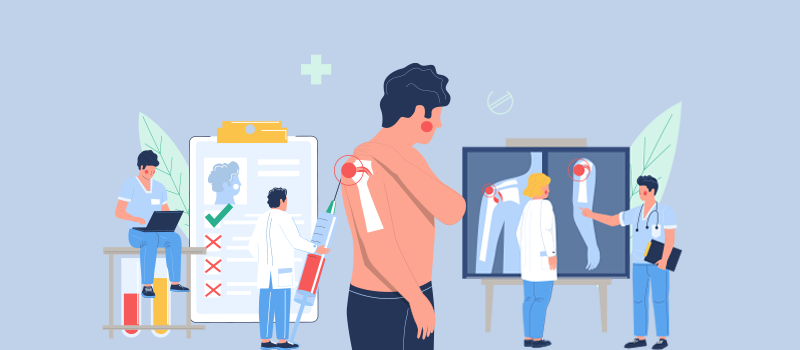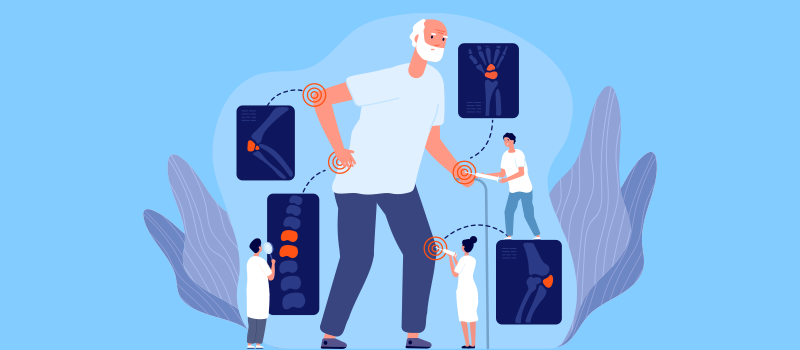Cervical Spinal Stenosis: Symptoms, Causes & Treatments

Key Takeaways
-
Cervical spinal stenosis is when the stenosis (narrowing) affects the bones in the neck (cervical spine). The thoracic spine (mid-back) and lumbar spine (lower back) can also be affected. Cervical and lumbar spinal stenosis are more common. Common symptoms are lower back pain, neck pain, numbness, tingling, and weakness in the hands, arms, feet, and legs, and clumsiness (such as difficulty buttoning shirts or writing).
-
Cervical spinal stenosis is usually caused by changes in the bone structure due to degeneration (wear and tear over time). It frequently affects people over 50 years of age. Maintaining a healthy lifestyle can lower your chances of developing cervical spinal stenosis.
-
Treatment options for cervical spinal stenosis include medication, physical therapy, steroids, and different surgeries, depending on the severity of your condition.
Cervical spinal stenosis is a common cause of neck pain and frequently affects people over 50 years of age. Please continue reading to find out the causes of spinal stenosis as well as symptoms and treatment options.
What is cervical spinal stenosis?
Stenosis means the narrowing or compression of the spinal canal. When the spinal canal narrows, it creates pressure on the spinal cord and nerve roots of the spinal nerves that exit the spinal canal, irritating them and causing symptoms.
When the stenosis (narrowing) affects the bones (vertebrae) in the neck (cervical spine), it is called cervical spinal stenosis. The thoracic spine (mid-back) and lumbar spine (lower back) can also be affected. Cervical and lumbar spinal stenosis are more common.
Age is one of the most common risk factors for these spinal problems. Up to 95% of people over 50 years of age have degenerative changes in the spine, one of which is spinal stenosis.
What causes the narrowing of the spinal canal and pressure on the spinal cord?
A common cause of spinal stenosis is changes in the bone structure due to degeneration (wear and tear over time).
These changes include the formation of bone spurs, which are small bony overgrowths that make the spinal column narrower, putting pressure on the spinal cord or nerves. Bone spurs can form due to spinal arthritis or Paget’s disease of bone. Not everyone with spinal arthritis or Paget's disease will develop bone spurs, and bone spurs can also occur independently of these conditions. Thickened ligaments and facet joints due to arthritic changes can have the same effects.
Degeneration also leads to a loss of water in the spinal vertebrae, causing bulging and herniated discs and collapse of the vertebrae. This also causes the narrowing of the tunnels through which spinal nerves leave the spinal canal.
Other less common causes of spinal stenosis include congenital stenosis (present since birth), trauma (spinal fractures and injuries), and spinal cysts or tumors that grow and cause narrowing of the spinal canal.
What does cervical spinal stenosis feel like?
Common symptoms of spinal stenosis in the cervical vertebrae include neck pain, numbness, tingling, and weakness in the hands, arms, feet, and legs, and clumsiness (such as difficulty buttoning shirts or writing). The pain associated with cervical spinal stenosis can be different in different people, ranging from a constant dull ache to a burning, electric pain that comes and goes.
Other symptoms of lumbar spinal stenosis include lower back pain, a feeling of heaviness in the legs, pain that is worse with long periods of standing, walking uphill, or bending, and, in severe cases, balance problems and difficulty walking.
How do doctors diagnose cervical and lumbar stenosis?
Doctors can diagnose spinal stenosis based on medical history, physical exam, and imaging tests such as a spine X-ray, magnetic resonance imaging (MRI), computed tomography (CT scan), and CT myelogram to visualize the spinal cord and nerves.
What is the treatment for cervical spinal stenosis?
Nonsurgical treatments
-
Over-the-counter nonsteroidal anti-inflammatory drugs (NSAIDs) such as naproxen and ibuprofen for pain relief.
-
Prescription medications for nerve pain (gabapentin) or muscle relaxants (baclofen, cyclobenzaprine, methocarbamol).
-
Physical therapy to improve strength, flexibility, and spinal stability.
-
Steroid injections to reduce inflammation and swelling and create more room for the spinal cord and nerves.
-
Lifestyle modifications such as maintaining good posture and regular exercise help to manage cervical spinal stenosis.
Surgical treatments
If cervical spinal stenosis compresses the spinal cord, decompressive surgery is usually necessary to treat the myelopathy (injury to the spinal cord). Some patients are candidates for minimally invasive surgery, while others require an open surgical approach. Some of the surgical procedures done to treat cervical spinal stenosis include:
-
Laminectomy, where the surgeon removes a part of one vertebra called the lamina, along with bone spurs and ligaments to make more room for the spinal cord.
-
Laminoplasty, in which a part of the lamina is removed, and the gap is bridged with metal plates and screws.
-
Foraminotomy, where bone and soft tissue are removed to make the foramen (small tunnels through which nerve roots exit) wider.
-
Spinal fusion surgery which involves fusing two vertebrae together. This is the last resort if other treatments have not been successful and there is radiating pain due to cervical spinal stenosis.
What should you not do with cervical spinal stenosis?
If you have received a diagnosis of cervical spinal stenosis, you should avoid strenuous neck rotation exercises. Keep in mind that exercise is important to strengthen your neck muscles, but you should check with your provider about which exercises are safe to do. You should also avoid neck strains, awkward neck postures, poor sleeping positions, and contact sports that can put you at risk of injuries to the cervical spine.
What happens if cervical stenosis is left untreated?
In extreme cases, if cervical spinal stenosis is left untreated, it can cause complications such as incontinence (loss of bladder or bowel control), sexual dysfunction (erectile dysfunction, inability to have orgasms), and leg paralysis.
How to prevent cervical spinal stenosis?
Cervical spinal stenosis is a degenerative condition that occurs due to normal wear and tear over time. You can lower your risk of developing cervical stenosis and improve your overall health by eating a healthy diet, maintaining a healthy body weight, getting regular exercise, keeping a good posture, avoiding smoking, and using the recommended safety gear during contact sports to prevent spinal injuries.
Save on Your Medication with BuzzRx!
Manage your medication costs with BuzzRx coupons. Here are direct links to substantial savings for each medication:
-
Naproxen Coupon: The retail price is as high as $36.11, but with BuzzRx, you might pay as low as $6.55.
-
Ibuprofen Coupon: Typical retail prices range between $12.83 and $29.99, and with BuzzRx coupons, you could pay as low as $5.12.
-
Gabapentin Coupon: Retail prices are as high as $478.99. With BuzzRx coupons, pay as low as $9.03.
-
Baclofen Coupon: The usual price is about $54.80. With BuzzRx coupons, pay as low as $18.01.
-
Cyclobenzaprine Coupon: The retail price is about $20.44. With BuzzRx coupons, pay as little as $5.63.
-
Methocarbamol Coupon: The retail price is around $17.99. With BuzzRx coupons, you could pay as low as $5.02.
Remember, these coupons are widely accepted at over 60,000 pharmacies, including major chains like CVS, Walgreens, and Rite Aid. Just present your coupon at the pharmacy to ensure you're getting the best possible price.
References:












SOCIAL